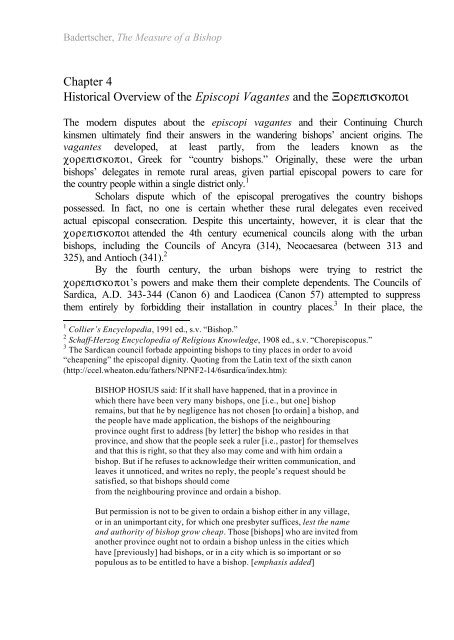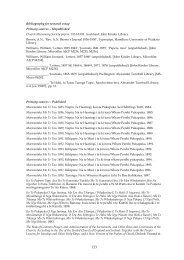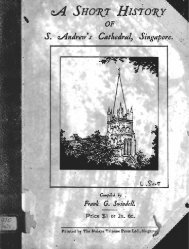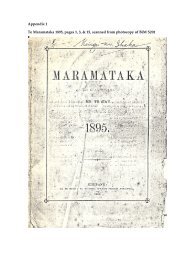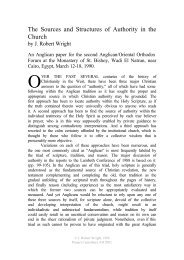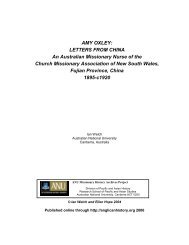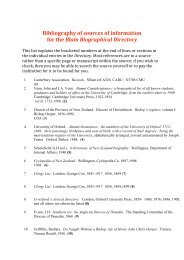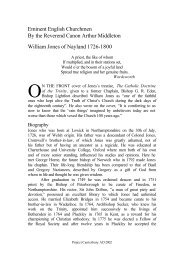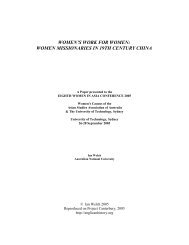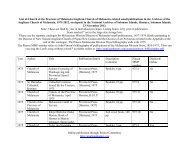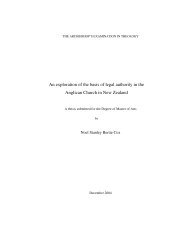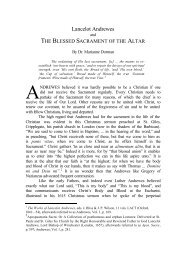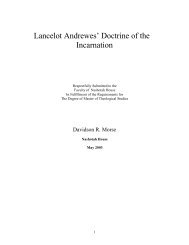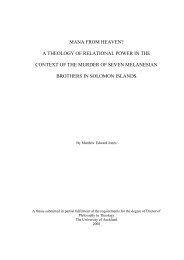Chapter 4 Historical Overview of the Episcopi Vagantes and the ...
Chapter 4 Historical Overview of the Episcopi Vagantes and the ...
Chapter 4 Historical Overview of the Episcopi Vagantes and the ...
- No tags were found...
Create successful ePaper yourself
Turn your PDF publications into a flip-book with our unique Google optimized e-Paper software.
Badertscher, The Measure <strong>of</strong> a Bishop<strong>Chapter</strong> 4<strong>Historical</strong> <strong>Overview</strong> <strong>of</strong> <strong>the</strong> <strong>Episcopi</strong> <strong>Vagantes</strong> <strong>and</strong> <strong>the</strong> ΞορεπισκοποιThe modern disputes about <strong>the</strong> episcopi vagantes <strong>and</strong> <strong>the</strong>ir Continuing Churchkinsmen ultimately find <strong>the</strong>ir answers in <strong>the</strong> w<strong>and</strong>ering bishops’ ancient origins. Thevagantes developed, at least partly, from <strong>the</strong> leaders known as <strong>the</strong>χορεπισκοποι, Greek for “country bishops.” Originally, <strong>the</strong>se were <strong>the</strong> urbanbishops’ delegates in remote rural areas, given partial episcopal powers to care for<strong>the</strong> country people within a single district only. 1Scholars dispute which <strong>of</strong> <strong>the</strong> episcopal prerogatives <strong>the</strong> country bishopspossessed. In fact, no one is certain whe<strong>the</strong>r <strong>the</strong>se rural delegates even receivedactual episcopal consecration. Despite this uncertainty, however, it is clear that <strong>the</strong>χορεπισκοποι attended <strong>the</strong> 4th century ecumenical councils along with <strong>the</strong> urbanbishops, including <strong>the</strong> Councils <strong>of</strong> Ancyra (314), Neocaesarea (between 313 <strong>and</strong>325), <strong>and</strong> Antioch (341). 2By <strong>the</strong> fourth century, <strong>the</strong> urban bishops were trying to restrict <strong>the</strong>χορεπισκοποι’s powers <strong>and</strong> make <strong>the</strong>m <strong>the</strong>ir complete dependents. The Councils <strong>of</strong>Sardica, A.D. 343-344 (Canon 6) <strong>and</strong> Laodicea (Canon 57) attempted to suppress<strong>the</strong>m entirely by forbidding <strong>the</strong>ir installation in country places. 3 In <strong>the</strong>ir place, <strong>the</strong>1 Collier’s Encyclopedia, 1991 ed., s.v. “Bishop.”2 Schaff-Herzog Encyclopedia <strong>of</strong> Religious Knowledge, 1908 ed., s.v. “Chorepiscopus.”3 The Sardican council forbade appointing bishops to tiny places in order to avoid“cheapening” <strong>the</strong> episcopal dignity. Quoting from <strong>the</strong> Latin text <strong>of</strong> <strong>the</strong> sixth canon(http://ccel.wheaton.edu/fa<strong>the</strong>rs/NPNF2-14/6sardica/index.htm):BISHOP HOSIUS said: If it shall have happened, that in a province inwhich <strong>the</strong>re have been very many bishops, one [i.e., but one] bishopremains, but that he by negligence has not chosen [to ordain] a bishop, <strong>and</strong><strong>the</strong> people have made application, <strong>the</strong> bishops <strong>of</strong> <strong>the</strong> neighbouringprovince ought first to address [by letter] <strong>the</strong> bishop who resides in thatprovince, <strong>and</strong> show that <strong>the</strong> people seek a ruler [i.e., pastor] for <strong>the</strong>mselves<strong>and</strong> that this is right, so that <strong>the</strong>y also may come <strong>and</strong> with him ordain abishop. But if he refuses to acknowledge <strong>the</strong>ir written communication, <strong>and</strong>leaves it unnoticed, <strong>and</strong> writes no reply, <strong>the</strong> people’s request should besatisfied, so that bishops should comefrom <strong>the</strong> neighbouring province <strong>and</strong> ordain a bishop.But permission is not to be given to ordain a bishop ei<strong>the</strong>r in any village,or in an unimportant city, for which one presbyter suffices, lest <strong>the</strong> name<strong>and</strong> authority <strong>of</strong> bishop grow cheap. Those [bishops] who are invited fromano<strong>the</strong>r province ought not to ordain a bishop unless in <strong>the</strong> cities whichhave [previously] had bishops, or in a city which is so important or sopopulous as to be entitled to have a bishop. [emphasis added]
Badertscher, The Measure <strong>of</strong> a Bishopcity bishops appointed priests as περιοδευται, or itinerant visitors. 4 By <strong>the</strong> eleventhcentury on <strong>the</strong> Continent, archdeacons had taken over most <strong>of</strong> <strong>the</strong> functions <strong>of</strong> <strong>the</strong>rural bishops. Part <strong>of</strong> <strong>the</strong> urban bishops’ dislike for itinerants was that <strong>the</strong> latter upset<strong>the</strong> orderly business <strong>of</strong> diocesan administration.The country bishops may have provided some <strong>of</strong> <strong>the</strong> lineage <strong>of</strong> <strong>the</strong> lateritinerants, but not all. Even fully <strong>and</strong> properly consecrated urban bishops apparentlyhad to turn w<strong>and</strong>erer sometimes. At least in <strong>the</strong> Eastern Empire, a bishop usuallyturned itinerant due to deprivation <strong>of</strong> his <strong>of</strong>fice (but not his episcopal status) onaccount <strong>of</strong> heresy or misconduct. In o<strong>the</strong>r cases, <strong>the</strong> method <strong>of</strong> popular electionmight mean that a bishop “might be consecrated to a see which subsequently refusedto elect him,” an event which “compelled a number <strong>of</strong> prelates to w<strong>and</strong>er in order toseek a livelihood.” 5Western itinerants came in large numbers from Irel<strong>and</strong> as missionaries to <strong>the</strong>barbarized Continent, setting up monasteries <strong>and</strong> preaching <strong>the</strong> Gospel. The Irishpractice required only one, not three, bishops for every consecration; 6 because some<strong>of</strong> <strong>the</strong> post-Reformation vagantes trace <strong>the</strong>ir orders from <strong>the</strong> Irish, this factor hasalso caused <strong>the</strong> orders <strong>of</strong> <strong>the</strong> Continuing Church bishops to come into question. TheFor ano<strong>the</strong>r citation <strong>of</strong> this canon, see also <strong>the</strong> work <strong>of</strong> German bishop <strong>and</strong> <strong>the</strong>ologian <strong>the</strong>Right Reverend Charles Joseph Hefele, bishop <strong>of</strong> Rottenburg <strong>and</strong> a pr<strong>of</strong>essor <strong>of</strong> <strong>the</strong>ology at<strong>the</strong> Unversity <strong>of</strong> Tübingen. Charles Joseph Hefele, A History <strong>of</strong> <strong>the</strong> Councils <strong>of</strong> <strong>the</strong> Church,From <strong>the</strong> Original Documents, vol. II, A.D. 326 to A.D. 429, from <strong>the</strong> German <strong>and</strong> ed. byHenry Nutcombe Oxenham (Edinburgh: T. & T. Clark, 1896), 135. Cf. Oxford Dictionary <strong>of</strong><strong>the</strong> Christian Church, 1974 ed., s.v. “Chorepiscopus.” One can see how in just four centuriesfrom <strong>the</strong> time <strong>of</strong> Christ, <strong>the</strong> bishops were already moving away from concerns aboutevangelizing <strong>the</strong> lost, to concerns about <strong>the</strong>ir own “dignity.”As for Canon 57 <strong>of</strong> <strong>the</strong> Council <strong>of</strong> Laeodicea(http://ccel.wheaton.edu/fa<strong>the</strong>rs/NPNF2-14/2ancyra/Laocns.htm), it reads:BISHOPS must not be appointed in villages or country districts, butvisitors; <strong>and</strong> those who have been already appointed must do nothingwithout <strong>the</strong> consent <strong>of</strong> <strong>the</strong> bishop <strong>of</strong> <strong>the</strong> city. Presbyters, in like manner,must do nothing without <strong>the</strong> consent <strong>of</strong> <strong>the</strong> bishop.For ano<strong>the</strong>r citation <strong>of</strong> <strong>the</strong> Laodicean canon, see also Hefele, A History <strong>of</strong> <strong>the</strong>Councils <strong>of</strong> <strong>the</strong> Church, vol. II, p. 321, 322.4 Schaff-Herzog, s.v. “Chorepiscopus.” Cf. ODCC, s.v., “Chorepiscopus.”5 Br<strong>and</strong>reth, <strong>Episcopi</strong> <strong>Vagantes</strong> <strong>and</strong> <strong>the</strong> Anglican Church, 1.6 This may have been due partly because <strong>of</strong> <strong>the</strong> exigencies <strong>of</strong> <strong>the</strong> Irish situation. There wereno cities in Irel<strong>and</strong> when Christianity first arrived <strong>the</strong>re in late Antiquity, only tribalsettlements. The monasteries, though eventually numerous, were still merely frontieroutposts <strong>of</strong> civilization as compared with <strong>the</strong> well-settled regions <strong>of</strong> <strong>the</strong> Mediterranean. Itwas not always easy or even possible to ga<strong>the</strong>r three bishops toge<strong>the</strong>r for <strong>the</strong> consecration <strong>of</strong>ano<strong>the</strong>r bishop. For an overview <strong>of</strong> <strong>the</strong> Irish church, <strong>and</strong> <strong>the</strong> missionaries’ contribution toWestern civilization, see Thomas Cahill, How <strong>the</strong> Irish Saved Civilization: The Untold Story<strong>of</strong> Irel<strong>and</strong>’s Heroic Role from <strong>the</strong> Fall <strong>of</strong> Rome to <strong>the</strong> Rise <strong>of</strong> Medieval Europe (New York:Nan A. Talese, Doubleday, c. 1995).
Badertscher, The Measure <strong>of</strong> a Bishopmodern episcopus vagans, on <strong>the</strong> o<strong>the</strong>r h<strong>and</strong>, “is less easy to classify than hispredecessor, <strong>and</strong> <strong>the</strong> grounds <strong>of</strong> objection against him are different. In some respects<strong>the</strong> title is misleading, since <strong>the</strong> majority <strong>of</strong> <strong>the</strong>se prelates do not w<strong>and</strong>er as <strong>the</strong>irpredecessors did.” 7 Yet <strong>the</strong> majority <strong>of</strong> <strong>the</strong> modern vagantes combine <strong>the</strong>disadvantages <strong>of</strong> both eras: “<strong>the</strong>y invade jurisdiction, <strong>and</strong> in most cases <strong>the</strong>irepiscopal status is doubtful.” 8A helpful starting point in defining <strong>the</strong> modern episcopi vagantes might befound in <strong>the</strong> Oxford Dictionary <strong>of</strong> <strong>the</strong> Christian Church, which states bluntly thatthis is <strong>the</strong> namegiven to persons who have been consecrated bishop in an irregular orcl<strong>and</strong>estine manner or who have been excommunicated by <strong>the</strong> Church thatconsecrated <strong>the</strong>m <strong>and</strong> are in communion with no recognized see. A man isalso included in this group when <strong>the</strong> number in communion with him is sosmall that his sect appears to exist for his own sake. 9 [emphasis added]Br<strong>and</strong>reth restates <strong>the</strong>se conditions to say that in some cases, “<strong>the</strong>re is not even <strong>the</strong>pretense <strong>of</strong> an organized church.” 10The Western Church’s <strong>the</strong>ology is generally ready to admit that <strong>the</strong>seirregular consecrations are valid, an admission which seems to follow <strong>the</strong> Latins’penchant for lawyerly definitions. The Eastern Church, on <strong>the</strong> o<strong>the</strong>r h<strong>and</strong>, declaresthat one must be in communion with <strong>the</strong> Church (by which she means herself) inorder to be a valid bishop.In <strong>the</strong> Anglican breakaway movements <strong>of</strong> <strong>the</strong> 19th <strong>and</strong> early 20th centuries,to which <strong>the</strong> Continuing Church is an heir, one finds several main streams <strong>of</strong>succession from <strong>the</strong> vagantes: 111) Julius Ferrete (or “Ferrette,” according to Anson)2) Dr. J. Joseph Overbeck3) Ambrose Phillipps de Lisle4) Joseph René Vilatte5) Ulric Vernon Herford6) Arnold Harris Ma<strong>the</strong>wFor <strong>the</strong> purposes <strong>of</strong> this <strong>the</strong>sis, <strong>the</strong> three most important are Ferrete, Vilatte, <strong>and</strong>Ma<strong>the</strong>w, for it is from <strong>the</strong>m that most <strong>of</strong> <strong>the</strong> American churches seem to take <strong>the</strong>irorders.Ferrete, a Frenchman who styled himself <strong>the</strong> “Bishop <strong>of</strong> Iona,” was <strong>the</strong> first<strong>of</strong> <strong>the</strong> modern vagantes. He was apparently born in France <strong>of</strong> Protestant parents, but7 Br<strong>and</strong>reth, 1.8 Ibid.9 ODCC, 1974 ed., s.v. “<strong>Episcopi</strong> vagantes.”10 Br<strong>and</strong>reth, 2.11 Anson, from <strong>the</strong> table <strong>of</strong> contents.
Badertscher, The Measure <strong>of</strong> a Bishopwas as a youth received into <strong>the</strong> Roman Catholic Church. 12 In 1851 he became anovice <strong>of</strong> <strong>the</strong> French Province <strong>of</strong> <strong>the</strong> Friars Preachers at Flavigny, <strong>and</strong> was given <strong>the</strong>religious name <strong>of</strong> Raymond. He pr<strong>of</strong>essed <strong>the</strong> following year, <strong>and</strong> <strong>the</strong>n studied inParis <strong>and</strong> Grenoble in philosophy <strong>and</strong> <strong>the</strong>ology. By 1854, he was living in Romewith <strong>the</strong> Italian Dominicans at S. Maria sopra Minerva. Ordained a deacon on April7, 1855, <strong>and</strong> a priest on June 2, he was <strong>the</strong>n ordered to join <strong>the</strong> Dominican Mission<strong>of</strong> Mesopotamia <strong>and</strong> Kurdistan. Surprisingly, only a year later he had given up hisfaith in Catholicism; he said as much a June 17, 1856 letter to his abbot, Père J<strong>and</strong>el.Ferrette also at this time said he no longer regarded himself as a Dominican. 13Following this, Ferrete headed toward Protestantism, making contact withboth <strong>the</strong> Anglican Bishop Gobat in Jerusalem, <strong>and</strong> <strong>the</strong>n with <strong>the</strong> Irish PresbyterianMission in Damascus. While still in <strong>the</strong> East, Ferrete became friendly with MarBedros, Bishop <strong>of</strong> Emesa (Homs), <strong>of</strong> <strong>the</strong> Syrian Jacobite Church. 14Pivotal in Ferrete’s life is an incident for which Anson says no documentaryevidence has been produced—that “Mar Bedros had obtained <strong>the</strong> sanction <strong>of</strong>Patriarch Mar Ignatius Jacobus II to initiate a sort <strong>of</strong> Reunion Movement, <strong>and</strong>,because Mar Bedros was unable to leave his diocese, he was looking for a likelyperson to direct this movement in Europe.” 15 The incident is important, despite <strong>the</strong>lack <strong>of</strong> pro<strong>of</strong>, because so many <strong>of</strong> <strong>the</strong> autocephalous churches trace <strong>the</strong>ir descentfrom Ferrete. Fur<strong>the</strong>r is it alleged thathaving discussed <strong>the</strong> introduction <strong>of</strong> Eastern Christianity into WesternEurope (without reference to Monophysitism), Mar Bedros managed topersuade Ferrette to take <strong>the</strong> leading part in it. Then, so we are told, with <strong>the</strong>sanction <strong>of</strong> <strong>the</strong> Jacobite Patriarch <strong>of</strong> Antioch, <strong>the</strong> Bishop <strong>of</strong> Emesa (Homs)raised <strong>the</strong> French “Minister <strong>of</strong> <strong>the</strong> Gospel” to <strong>the</strong> episcopate on June 2, 1866(Old Style); <strong>and</strong> that <strong>the</strong> function took place in Homs, in <strong>the</strong> presence <strong>of</strong>many witnesses. 16Ferrete, who received <strong>the</strong> title “Bishop <strong>of</strong> Iona,” was <strong>the</strong>n dispatched as“Patriarchal Legate for Western Europe,” with <strong>the</strong> authority to erect indigenousOrthodox Churches under <strong>the</strong>ir own, autonomous Patriarchate. 1712 Ibid., 33.13 Ibid., 34.14 “‘Jacobite’ is <strong>the</strong> name by which a number <strong>of</strong> Monophysite Churches, including <strong>the</strong>Syrian Church, are commonly called. The name derived from Jacob Baradaeus, Bishop <strong>of</strong>Edessa (541-78), who saved <strong>the</strong> Monophysite heretics from <strong>the</strong> extinction which threatened<strong>the</strong>m through persecution. They were accused <strong>of</strong> so identifying <strong>the</strong> two natures <strong>of</strong> Christ soas to obliterate <strong>the</strong> real distinction between <strong>the</strong> divine <strong>and</strong> <strong>the</strong> human.” Footnote 3, Anson, p.35.15 Anson, 35.16 Ibid., 36.17 Ibid., 36.
Badertscher, The Measure <strong>of</strong> a BishopJoseph René Vilatte, <strong>the</strong> second most prolific figure among <strong>the</strong> 19th <strong>and</strong> 20thcentury vagantes, was a Parisian who emigrated to America at an early age. 18 UnlikeMa<strong>the</strong>w, who began his clerical career with a view to being an Anglican but becamea Roman Catholic, Vilatte initially intended to join <strong>the</strong> Catholic priesthood but latermoved toward Protestantism (<strong>of</strong> various varieties). For a short while, however, hewas a member <strong>of</strong> <strong>the</strong> Methodist church in Montreal, Quebec. This did not satisfyhim, however, <strong>and</strong> during <strong>the</strong> following years “his changes <strong>of</strong> religious affiliationwere numerous <strong>and</strong> bewildering. He four times returned to <strong>the</strong> Roman CatholicChurch, once to <strong>the</strong> Methodists, became a Congregationalist minister, <strong>and</strong> twice aPresbyterian.” 19 In 1885, he approached <strong>the</strong> PECUSA bishop <strong>of</strong> Fond du Lac,Wisconsin, Dr. Hobart Brown, to ask about becoming ordained as a priest in thatchurch. His name appears in <strong>the</strong> <strong>of</strong>ficial record <strong>of</strong> <strong>the</strong> diocese as a c<strong>and</strong>idate forHoly Orders. 20 At Brown’s suggestion, Vilatte went for ordination to Dr. Herzog,<strong>the</strong> Old Catholic 21 bishop in Switzerl<strong>and</strong>. In June, 1885, Herzog ordained Vilatte asa deacon <strong>and</strong> <strong>the</strong>n as a priest; <strong>the</strong> new priest’s oath <strong>of</strong> canonical obedience, however,was made to <strong>the</strong> Protestant Episcopal Church bishop <strong>of</strong> Fond du Lac. 22 Although heapparently served well in his work in his mission, at <strong>the</strong> time <strong>of</strong> Dr. Brown’s deathin 1888, Vilatte was “intriguing with <strong>the</strong> Old Catholics with a view to beingconsecrated bishop.” 23 When Dr. C.C. Grafton, Brown’s successor as <strong>the</strong> PECUSAbishop <strong>of</strong> Fond du Lac, refused to consecrate Vilatte as “Bishop-Abbot” <strong>of</strong> <strong>the</strong>American Old Catholics, Vilatte <strong>the</strong>n entered into relations with <strong>the</strong> RussianArchbishop Vladimir, “who, while not <strong>of</strong>fering him consecration, appears to havegranted him some form <strong>of</strong> recognition.” 24 Vilatte <strong>the</strong>n claimed to have been electedto <strong>the</strong> episcopate by <strong>the</strong> Old Catholics <strong>the</strong>mselves, at a synod at Duvall(Wisconsin?). In remarks printed in The Church Review, October, 1898 to January,1899, Grafton remarked on <strong>the</strong> Synod,“The story that he was elected to <strong>the</strong> bishopric <strong>of</strong> <strong>the</strong> Old Catholics is simplythis: He carried around a paper amongst <strong>the</strong> few poor, ignorant people under18 Br<strong>and</strong>reth, 47.19 Br<strong>and</strong>reth, 47.20 Ibid.21 The Old Catholics were a movement in <strong>the</strong> German-speaking Europe which rejected <strong>the</strong> FirstVatican Council’s (1870) declaration <strong>of</strong> <strong>the</strong> dogma <strong>of</strong> papal infallibility. The historian <strong>and</strong><strong>the</strong>ologian J.J.I. von Döllinger (1799-1890), with o<strong>the</strong>rs, founded Catholic churches whichwere not in communion with Rome. The separatists designated <strong>the</strong>mselves “Old Catholics,”because <strong>the</strong>y claimed Rome had created a new church through decrees such as those <strong>of</strong> <strong>the</strong>Vatican Council. Good relations have existed between <strong>the</strong> Anglicans <strong>and</strong> <strong>the</strong> Old Catholicssince <strong>the</strong> movement’s beginning; in 1925, <strong>the</strong> Old Catholics recognized Anglicanordinations, <strong>and</strong> later obtained full communion with <strong>the</strong> Church <strong>of</strong> Engl<strong>and</strong> (in 1932), <strong>and</strong>most <strong>of</strong> <strong>the</strong> o<strong>the</strong>r Anglican churches.22 Br<strong>and</strong>reth, 47, 48.23 Ibid., 48.24 Br<strong>and</strong>reth, 48.
Badertscher, The Measure <strong>of</strong> a Bishophis charge, which he dem<strong>and</strong>ed that <strong>the</strong>y should sign. Most <strong>of</strong> <strong>the</strong>mcomplied, some <strong>of</strong> <strong>the</strong>m being little children. There is only one clergyman’sname on <strong>the</strong> petition <strong>and</strong> that, according to <strong>the</strong> statement <strong>of</strong> <strong>the</strong> clergyman sonamed, was forged.”Vilatte was finally consecrated in Ceylon by “Archbishop Alvares” <strong>of</strong> <strong>the</strong>“Independent Catholic Church <strong>of</strong> Goa <strong>and</strong> Ceylon.” 25 At <strong>the</strong> General Convention <strong>of</strong>1892, <strong>the</strong> Protestant Episcopal Church responded to this consecration with certainresolutions. The bishops concluded that Vilatte had obtained his consecration from aChurch separated from Catholic Christendom because <strong>of</strong> its non-acceptance <strong>of</strong> <strong>the</strong>Chalcedonian definition <strong>of</strong> <strong>the</strong> Person <strong>of</strong> <strong>the</strong> Lord Jesus Christ. Also, <strong>the</strong>y affirmedthat Vilatte was never elected by a duly accredited synod, <strong>and</strong> that he seemedanxious to obtain <strong>the</strong> episcopate from any body which would give it to him.Additionally, <strong>the</strong>y declared that <strong>the</strong>se non-Catholic bishops had no jurisdiction orright to ordain a bishop for any part <strong>of</strong> <strong>the</strong> diocese under <strong>the</strong> jurisdiction <strong>of</strong> <strong>the</strong>bishop <strong>of</strong> Fond du Lac. 26 They also found that more than two months before <strong>the</strong> time<strong>of</strong> his so-called consecration, he was deposed from <strong>the</strong> sacred ministry. 27 Therefore,<strong>the</strong> Episcopal Church declared Vilatte’s orders null <strong>and</strong> void, <strong>and</strong> resolved to sendmessages to <strong>the</strong> Old Catholics about this.Arnold Harris Ma<strong>the</strong>w is <strong>the</strong> ano<strong>the</strong>r important figure from whom <strong>the</strong>modern “Continuing Churches” trace <strong>the</strong>ir origins. He originally prepared for ordersin <strong>the</strong> Church <strong>of</strong> Engl<strong>and</strong>, but in 1878 was ordained as a Roman Catholic priest. 28He spent some years in service as a parish priest in various cures, but “a set <strong>of</strong>unfortunate circumstances for which he was not personally responsible caused himto leave <strong>the</strong> Roman Catholic Church; later he married.” 29 For a while, he served asan Anglican curate at Holy Trinity Church, Sloane Street, London, Engl<strong>and</strong>, with <strong>the</strong>sanction but not <strong>the</strong> license <strong>of</strong> Dr. Frederick Temple, <strong>the</strong> Bishop <strong>of</strong> London. 30In 1907, after he had resigned from this curacy, <strong>and</strong> an effort to find ano<strong>the</strong>rministerial charge in <strong>the</strong> Church <strong>of</strong> Engl<strong>and</strong> had failed, Ma<strong>the</strong>w was approached byan ex-Roman Catholic priest, Richard O’Halloran, “who informed him that <strong>the</strong>rewere two hundred <strong>and</strong> fifty priests <strong>and</strong> congregations who wished for <strong>the</strong>ministrations <strong>of</strong> an Old Catholic Bishops, <strong>and</strong> that <strong>the</strong>y had elected Ma<strong>the</strong>w to that<strong>of</strong>fice. Negotiations were opened with <strong>the</strong> See <strong>of</strong> Utrecht, <strong>and</strong> Ma<strong>the</strong>w wrote25 Ibid., 49, 50.26 Ibid., 52, 53.27 Footnote 1 from Br<strong>and</strong>reth, 53. “He was degraded from <strong>the</strong> priesthood <strong>and</strong>excommunicated by <strong>the</strong> Protestant Episcopal Church on 21 March 1892.”28 Br<strong>and</strong>reth, 16.29 Ibid.30 Ibid.
Badertscher, The Measure <strong>of</strong> a Bishopinforming <strong>the</strong> Archbishop <strong>of</strong> Canterbury <strong>of</strong> what was going forward.” 31 On April 28,1908, Ma<strong>the</strong>w was consecrated bishop in St. Gertrude’s Ca<strong>the</strong>dral in Utrecht, <strong>the</strong>Ne<strong>the</strong>rl<strong>and</strong>s, by <strong>the</strong> Old Catholic Archbishop Gul, who was assisted by <strong>the</strong> OldCatholic bishops <strong>of</strong> Haarlem (J.J. van Thiel), Deventer (N.B.P. Spit) <strong>and</strong> Germany(J. Demmel). 32 When <strong>the</strong> newly-made Bishop Ma<strong>the</strong>w returned to Engl<strong>and</strong>,immediately after his consecration, he “appears at once to have discovered that <strong>the</strong>information given him by O’Halloran was entirely false, <strong>and</strong> that <strong>the</strong> actual number<strong>of</strong> those willing to accept his ministrations was negligible. There seems to be nodoubt that Ma<strong>the</strong>w immediately informed Utrecht <strong>of</strong> <strong>the</strong> true state <strong>of</strong> affairs <strong>and</strong>added a request that he might be permitted to retire.” The Dutch bishops exoneratedhim from personal blame, through a letter. 33 Br<strong>and</strong>reth considers that <strong>the</strong>re is noreason to doubt <strong>the</strong> Old Catholic Dutch bishops’ view that O’Halloran was to blamefor <strong>the</strong> confusion. 34For <strong>the</strong> next two years, Ma<strong>the</strong>w for two years following his consecration,Ma<strong>the</strong>w remained in full communion with <strong>the</strong> See <strong>of</strong> Utrecht, having <strong>the</strong> status <strong>of</strong> amissionary bishop 35 In October 1909, Ma<strong>the</strong>w assisted in Utrecht at ArchbishopGul’s consecration <strong>of</strong> <strong>the</strong> Mariavite bishop Jean Marie Kowalski. In September,1909, however, while attending <strong>the</strong> Old Catholic congress in Vienna, Ma<strong>the</strong>wclaimed to have discovered various differences between <strong>the</strong> Old Catholics <strong>of</strong>Switzerl<strong>and</strong> <strong>and</strong> Germany <strong>and</strong> <strong>the</strong> traditional position <strong>of</strong> <strong>the</strong> Church <strong>of</strong> <strong>the</strong>Ne<strong>the</strong>rl<strong>and</strong>s, notably with regard to <strong>the</strong> acceptance <strong>of</strong> <strong>the</strong> decrees <strong>of</strong> <strong>the</strong>Synod <strong>of</strong> Jerusalem (1672, <strong>the</strong> Sacrament <strong>of</strong> Penance, invocation <strong>of</strong> Saints,alterations to <strong>the</strong> liturgy, <strong>and</strong> <strong>the</strong>ir general attitude toward <strong>the</strong> Pope. 36Then, in December, 1910, Ma<strong>the</strong>w issued a “Pastoral Letter,” in which he declaredhis autonomy <strong>and</strong> independence. 37 Ten years later, in 1920, <strong>the</strong> Old Catholic bishopsmade a formal pronouncement against him, claiming that his consecration had been“‘surreptitiously secured by <strong>the</strong> production <strong>of</strong> false testimony, <strong>and</strong> would never havetaken place had <strong>the</strong> consecrators known that <strong>the</strong> conditions stated in <strong>the</strong> questionabledocuments <strong>and</strong> required by our Episcopate were non-existent.’” 38 The Dutch bishopsalso stated in this pronouncement that <strong>the</strong>y broke <strong>of</strong>f intercourse with Ma<strong>the</strong>w once<strong>the</strong>y discovered <strong>the</strong>se facts, “a statement which appears to be in error, for <strong>the</strong> Dutchbishops were in communion with Ma<strong>the</strong>w for two years after <strong>the</strong> facts were made31 Ibid.32 Br<strong>and</strong>reth, 16, 17.33 Ibid., 16.34 Ibid., 18.35 Ibid., 18.36 Ibid.37 Ibid. This letter is printed in Ma<strong>the</strong>w’s book The Catholic Church <strong>of</strong> Engl<strong>and</strong>, pp. 20ff.<strong>and</strong> in An Episcopal Odyssey, pp. 21ff.38 Ibid., 19. This excerpt is taken from <strong>the</strong> Report <strong>of</strong> <strong>the</strong> Lambeth Conference, 1920, 155.
Badertscher, The Measure <strong>of</strong> a Bishopknown to <strong>the</strong>m.” 39 At <strong>the</strong> time <strong>of</strong> Br<strong>and</strong>reth’s writing, in <strong>the</strong> 1960’s, <strong>the</strong> OldCatholic Church <strong>of</strong> Utrecht maintained that Ma<strong>the</strong>w’s consecration was obtainedmala fide, in bad faith, <strong>and</strong> <strong>the</strong>refore was null <strong>and</strong> void. The Lambeth Conference,however, only expressed doubts about <strong>the</strong> validity <strong>of</strong> Ma<strong>the</strong>w’s episcopal orders.Br<strong>and</strong>reth considers that Ma<strong>the</strong>w’s unsuitability for <strong>the</strong> episcopal <strong>of</strong>ficeshows, among o<strong>the</strong>r things, in <strong>the</strong> fact that within twelve months <strong>of</strong> <strong>the</strong> break with<strong>the</strong> see <strong>of</strong> Utrecht “five bishops had been consecrated without any see or flock beingassigned to <strong>the</strong>m.” 40 Of those whom he consecrated, at least two <strong>of</strong> <strong>the</strong>m (who hadwere deposed Monsignors <strong>of</strong> <strong>the</strong> Roman Catholic Church) refused to exercise <strong>the</strong>irepiscopate. 41 Following this fiasco, Ma<strong>the</strong>w’s clergy<strong>the</strong>n proceeded to elect four <strong>of</strong> <strong>the</strong>ir number <strong>and</strong> to press for <strong>the</strong>irconsecration. Ma<strong>the</strong>w acceded to <strong>the</strong>ir request... No reason seems to havebeen given as to why it was necessary to consecrate four men at once for amovement which had barely four places <strong>of</strong> worship, but in <strong>the</strong> event all <strong>the</strong>seprelates departed from <strong>the</strong> Rite after a short time. 42In April, 1916, Ma<strong>the</strong>w consecrated James Charles Thomas Ayliffe Williams, as hisperpetual coadjutor with right <strong>of</strong> succession. 43 This man, who assumed <strong>the</strong> names <strong>of</strong>Bernard Mary at his consecration, claimed that he represented <strong>the</strong> only legitimatecontinuation <strong>of</strong> Ma<strong>the</strong>w’s movement.For several reasons, Br<strong>and</strong>reth’s book is an invaluable Anglican resource forits contentions concerning <strong>the</strong> vagantes. Not only does it cite <strong>the</strong> LambethConferences’ resolutions concerning <strong>the</strong> itinerants, as well as contain introductoryremarks from two high-ranking English bishops to introduce his work, but <strong>the</strong>author was also on good personal terms with many <strong>of</strong> <strong>the</strong> itinerants about whom hewrote (despite his disagreement with <strong>the</strong>ir positions). The introductory matter,though, is what is especially <strong>of</strong> interest for this study, because <strong>of</strong> its attitude towardecumenism in general. In his commendation to Br<strong>and</strong>reth’s book, <strong>the</strong> <strong>the</strong>n-Archbishop <strong>of</strong> Canterbury, Ge<strong>of</strong>frey, Lord Fisher <strong>of</strong> Lambeth, wrote:The book has proved quit invaluable to all who are interested for one reasonor ano<strong>the</strong>r in <strong>the</strong> history <strong>and</strong> doings <strong>of</strong> <strong>the</strong> various successions <strong>of</strong> bishopswho operate without <strong>the</strong> authority or approval <strong>of</strong> any <strong>of</strong> <strong>the</strong> recognizedhistoric Churches <strong>of</strong> Christendom. 4439 Ibid., 19.40 Ibid., 21.41 Herbert Ignatius Beale <strong>and</strong> Arthur William Howarth told Ma<strong>the</strong>w that <strong>the</strong>y were simplygoing to continue <strong>the</strong>ir quarrel with Rome. Ibid., 20.42 Br<strong>and</strong>reth, 20, 21.43 Ibid., 21.44 Ge<strong>of</strong>frey, Lord Fisher <strong>of</strong> Lambeth, Archbishop <strong>of</strong> Canterbury, commendational forward toBr<strong>and</strong>reth., ix.
Badertscher, The Measure <strong>of</strong> a BishopIt is unclear whe<strong>the</strong>r <strong>the</strong> archbishop means by “<strong>the</strong> recognized historic Churches <strong>of</strong>Christendom” only those churches which possess <strong>the</strong> “Historic Episcopate.” If so,this would be but ano<strong>the</strong>r example <strong>of</strong> <strong>the</strong> Anglican sense <strong>of</strong> superiority to Methodist<strong>and</strong> Lu<strong>the</strong>ran episcopal orders.Fisher’s fellow prelate, Bishop Sherard Falkner Allison <strong>of</strong> Chelmsford,Engl<strong>and</strong>, 45 penned similar sentiments in his forward. Falkner cites Resolution 54 <strong>of</strong><strong>the</strong> 1958 Lambeth Conference, which said that Anglicanism “‘cannot recognize <strong>the</strong>Churches <strong>of</strong> such episcopi vagantes as properly constituted Churches or recognize<strong>the</strong> orders <strong>of</strong> <strong>the</strong>ir ministers.’” 46 The Lambeth Conferences <strong>of</strong> 1920 had also <strong>of</strong>feredwarnings against <strong>the</strong> itinerants.Br<strong>and</strong>reth objects to <strong>the</strong> itinerant bishops <strong>of</strong> his own day in large partbecause <strong>of</strong> what he considers almost a distinguishing feature <strong>of</strong> <strong>the</strong> entire class—a“light-hearted trafficking in holy things.” 47 Though he makes it clear that some <strong>of</strong><strong>the</strong> vagantes are honest, godly men, as he knows from his personal acquaintancewith <strong>the</strong>m, Br<strong>and</strong>reth asserts that <strong>the</strong>y are all mistaken in <strong>the</strong>ir episcopal claims.In his book Bishops at Large, Anson builds upon Br<strong>and</strong>reth’s assumptions.He points out that almost none <strong>of</strong> <strong>the</strong> founders <strong>of</strong> <strong>the</strong> “autocephalous” churches hashad a vision comparable to those <strong>of</strong> <strong>the</strong> 16th century Protestant Reformers or <strong>the</strong>irforerunners, for <strong>the</strong> restoration <strong>of</strong> primitive Christianity:In most cases <strong>the</strong>y have been quit content with <strong>the</strong> later developments <strong>of</strong>ecclesiastical polity, ritual <strong>and</strong> ceremonial. They have not been satisfied withbeing simple superintendents or overseers <strong>of</strong> <strong>the</strong>ir flocks which after all, is<strong>the</strong> meaning <strong>of</strong> <strong>the</strong> Greek word episcopos. In almost every instance <strong>the</strong>y havetaken over <strong>the</strong> late medieval or post-Tridentine conception <strong>of</strong> prelacy—lock,stock <strong>and</strong> barrel. 48Sadly, in his desire for orderly churchmanship, Br<strong>and</strong>reth apparentlyunchurches most <strong>of</strong> <strong>the</strong> Protestant world as well. He seems to take <strong>the</strong> tack that onlychurches which possess <strong>the</strong> “Historic Episcopate” may even claim <strong>the</strong> name <strong>of</strong>“bishop” for <strong>the</strong>ir superintendents <strong>and</strong> overseers. This is seen in <strong>the</strong> passing remarkhe makes about <strong>the</strong> numbers <strong>of</strong> <strong>the</strong> vagantes; as <strong>of</strong> his writing, he remarks, <strong>the</strong>reexisted more than 200 such w<strong>and</strong>erers, but45 Crockford’s Clerical Directory, 1975-76 edition, lists him under this name. It is not clearwhy he refers to himself this way in his forward to Br<strong>and</strong>reth. See Crockford’s ClericalDirectory: A Reference Book <strong>of</strong> <strong>the</strong> Clergy <strong>of</strong> <strong>the</strong> provinces <strong>of</strong> Canterbury <strong>and</strong> York <strong>and</strong>o<strong>the</strong>r Anglican Provinces <strong>and</strong> Dioceses, 1975-76. London: Oxford University Press, 1976,1448.46 Sherard Falkner Allison, forward to Br<strong>and</strong>reth, xi.47 Br<strong>and</strong>reth, xiii.48 Anson, 27.
Badertscher, The Measure <strong>of</strong> a Bishop<strong>the</strong> number is greatly increased if one adds <strong>the</strong> number <strong>of</strong> exotic sects inAmerica which claim to possess bishops, but do not claim a succession, <strong>and</strong><strong>the</strong> number <strong>of</strong> African natives who claim <strong>the</strong> title “bishop” merely in order togain prestige in <strong>the</strong> eyes <strong>of</strong> <strong>the</strong>ir tribe. 49One wonders whe<strong>the</strong>r <strong>the</strong>se “exotic sects” would include Methodists <strong>and</strong> Lu<strong>the</strong>rans,whose leaders are known as “bishops” but who do not claim <strong>the</strong> “HistoricEpiscopate.” In any case, to underst<strong>and</strong> <strong>the</strong> vagantes’ claims to valid episcopalministry, one must first underst<strong>and</strong> <strong>the</strong> competing views <strong>of</strong> apostolic succession, <strong>and</strong>it is <strong>the</strong>re that we turn our attention next.49 Br<strong>and</strong>reth, 2.


